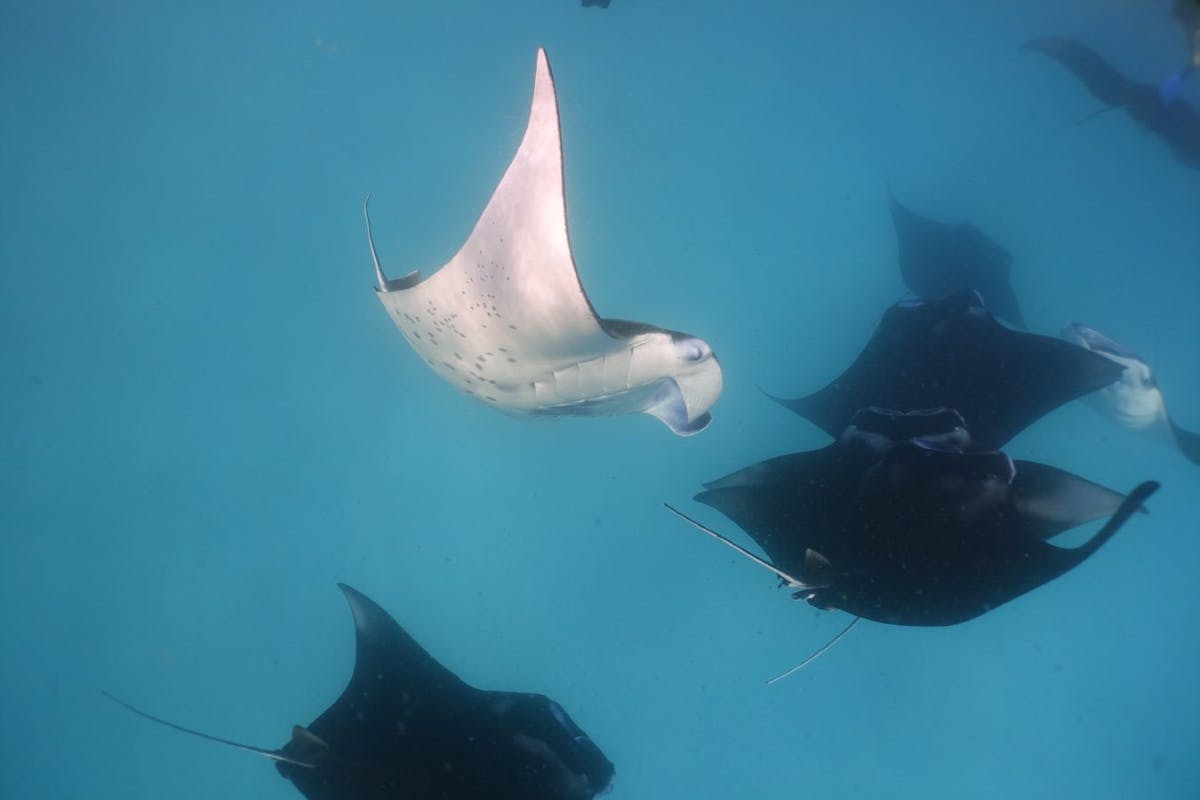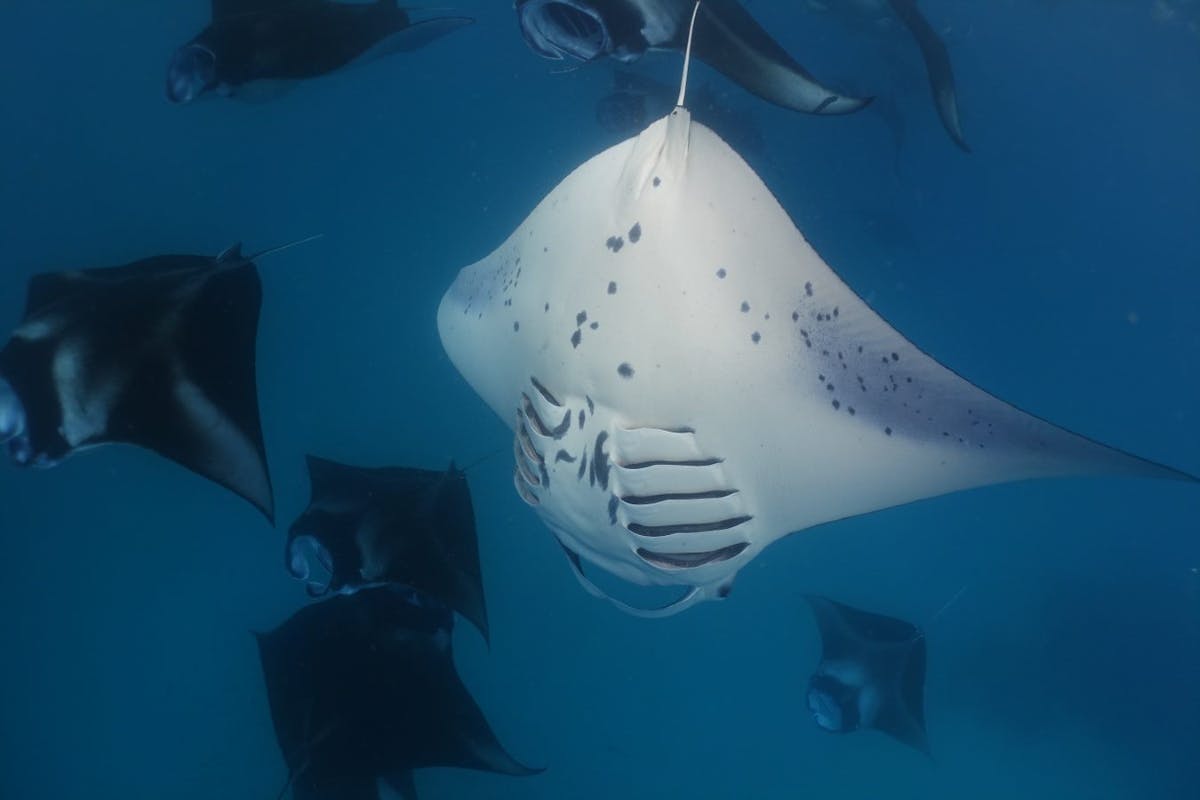Manta of Hanifaru Bay
I was lucky enough to work there in 2017/2018 and can say first hand that while the islands are beautiful, it is better under the surface.

Picture the Maldives, what are your first thoughts? White sandy beaches, turquoise lagoons, lush vegetation?
I worked as a marine biologist and diving instructor in South Male and then Baa Atoll, which includes a little spot called Hanifaru Bay. Part of the role involved contributing identification shots of marine megafauna, including turtles, manta and whale sharks.
Why Hanifaru Bay? Due to its shape, when currents are right plankton become concentrated in the Bay, making feeding more efficient for large planktivores such as the Reef Manta, Mobula alfredi, meaning huge numbers congregate there.
Located on the eastern edge of Baa Atoll, it forms part of the outer ring of islands and smaller atolls. There is an incredible range of habitats, including shallow and deeper reefs, cleaning stations, sandy bottoms, steep drop offs and wide channels.
In addition to Manta, it is possible to see various shark species, multitudes of fish and coral species, turtles, dolphins, and seabirds.
Hanifaru Bay
Due to the abundance of manta during the season, running May to November, and diverse habitats the area represents, has enjoyed designation as a UNESCO BiosphereReserve since 5th June, 2009.
This means some activities are prohibited, including scuba diving and fishing. It also restricts boat traffic, and limits the number of snorkelers.
It can still feel busy, but at times we were almost the only people in the bay. On one memorable occasion, I guided two guests on a private trip with approximately 200 manta in a mass vortex, with a small group on the far side of the action.
Rangers patrol the bay, monitoring boat activity, swimmers, and also inform resorts when the action is on.
Hanifaru Bay is an incredible place to photograph large numbers of manta displaying feeding behaviour, including barrel rolls, large trains and bottom feeding. Due to thepresence of cleaning stations, it is possible to catch shots of that too. Heads up, you do need to be a semi-capable freediver for the last part. The shallowest sits around 10m (30ft).
Want to do something different?
You can freedive and scuba dive the pinnacles near Dhigu Thila, it is possible to interact with manta and whale sharks. I recorded mating behaviour with 4 individuals and nearly received a chest bump from a juvenile (2.5m) whale shark!
Getting to Hanifaru Bay can be a scramble
Depending on which resort or island you are coming from, you may be able to wait for a call. Sign up for an excursion, and wait to hear that the rays are on. It’s then a case of get to the boat fast, get organised and go. Usually it’s a case of first in, best dressed.
Other resorts may have a day trip available where you take your chances. The action is heavily dependent on time and tide, moon cycle and the whim of the ocean.
Strobes are a no-no, as they disturb the animals' feeding.
As Manta are a protected species, within a Biosphere Reserve, you can probably guess there are restrictions on what you can and can't do.
Strobes are a no-no, as they disturb the animals' feeding. Likewise, freediving in front of the rays is strongly recommended against, although freediving wasn't prohibited entirely. On that, use your best judgement and listen to the guides.
As much of the action is near the surface, natural light is plenty to get amazing shots. Even at cleaning stations, it is possible to get great results without artificial light. The sandy bottom and relatively clear water keep things bright.
You may have noticed ‘relatively clear water’ there. As the manta are following the plankton, it can get a little muddled. On clearer days you may still find anywhere from 5 to 30 individuals, for example, but when the real numbers come in, it’s because the water column is full of food. The largest number recorded in one sitting was over 270.
Once you’ve had your fun, that doesn't have to be it. (Editing aside).The main conservation group is the Maldivian Manta Ray Project, led by the Manta Trust. I highly recommend checking them out for detailed information.
Like most megafauna, Mobula alfredi are in decline globally. This stems from direct fishing pressure, bycatch, boat strikes, pollution and unsustainable tourism.
Remember I mentioned identification shots earlier? So, images I collected were provided to the Manta Trust, alongside many other biologists and from their own team in the country.
Yon can identify individuals from their ventral markings (belly or underside). Each Manta has a unique series of markings, much like a fingerprint.
The Maldivian Manta Ray Project has recorded over 1800 individuals
The use of non- invasive methods to track movements of individuals around the Maldives and potentially further afield.
If you are lucky enough to be the first to photograph a manta, whale shark or turtle, you can generally request or be offered to have naming rights.
Having a large number of citizen scientists contributing to identification provides a powerful tool, used alongside methods such as satellite tags and emerging fields like environmental DNA, to aid in conservation efforts of this and many other species.
I was lucky enough to encounter a Whale Shark, Gas, on one excursion. While not easy to photograph the markings around the pectoral fins, on both sides, it was immensely satisfying to get a report from the Marine Megafauna Foundation identifying the individual.
Ironically, I was pretty gassed. After getting the left-hand side as it swam by, dropping behind the shark before sprinting along the right side to capture the complementary shot. They may appear to be cruising, but we are much less suited to their environment.
If you plan on interacting with marine megafauna, please check for guides on best practices, they are available online, and find operations or locations where they promote the wellbeing of animals you are fortunate enough to enjoy.







